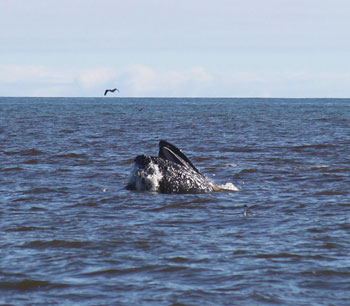Story and Photos by Maggie Caldwell

These are ripe conditions for the “lunge feeding” visible from local beaches. “It’s a slow, gentle bite for them. The bait is so thick it’s frozen; the humpbacks just come up from underneath and eat.”
Humpbacks feed only during the summertime on schools of sardines, anchovies, and krill. They can travel up to 16,000 miles during their annual migration from winter breeding grounds in Mexico north toward Alaska and back. Recently boaters and swimmers have been taken by surprise by the sudden appearance of a nearby humpback. A warning to small boaters, kayakers, and stand-up paddle boarders thinking about seeking out a whale for a closer look: enjoy the show from a distance. Humpback whales are protected under both federal 1972 Marine Mammal Protection Act as well as the Endangered Species Act. It’s illegal to approach within 100 yards of the animals with a minimum fine of $11,000. (However, there doesn’t seem to be a limit on how close the whale can approach you!)
Here are ten facts about Humpbacks from the American Cetacean Society and Sea Shepherd Conservation Society:
- Humpbacks are mammals that belong to the same family as the blue whale.
- They breathe voluntarily.
- The females are bigger than the males: from 45-50 feet to the males’ 40-48.
- Humpbacks eat up to 1.5 tons of food a day and feed only in the summer months.
- Baleen plates, not teeth, trap their food to be swallowed.
- Humpbacks are acrobatic, leaping completely out of the water and into the air; an acrobatic task for a 40-ton animal.
- They sing, and their songs are complex with each population singing its own unique song.
- Their songs are not inborn – they learn them from each other.
- They are found in all the worlds’ oceans and are capable of migrating the globe.
- Humpback whales have a life expectancy of 45-50 years.